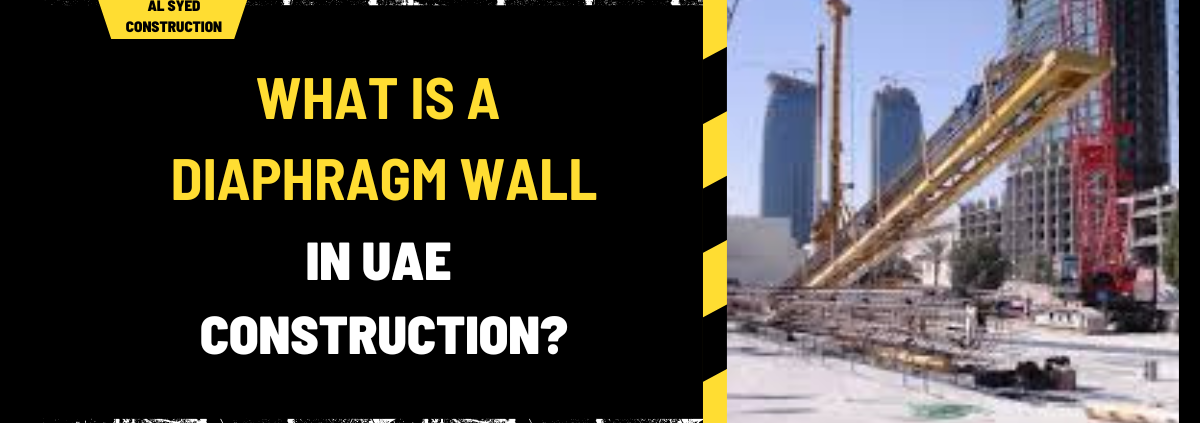What is a Diaphragm Wall in UAE Construction?
A diaphragm wall is a crucial structural element in modern construction, widely utilized for its ability to provide robust support and stability in challenging soil and water conditions. This detailed guide will explore the intricacies of diaphragm walls, their applications, construction techniques, and benefits, providing a comprehensive understanding of this essential construction component.
1. Understanding Diaphragm Walls
Definition and Purpose
A diaphragm wall is a deep foundation element typically constructed in reinforced concrete. It is used to support heavy loads, control groundwater, and provide lateral support for excavations. The wall acts as a vertical barrier that can resist significant soil and water pressures, making it ideal for deep excavations, basement construction, and projects in high-water-table areas.
Types of Diaphragm Walls
- Continuous Diaphragm Walls: These are uninterrupted walls extending through the entire depth of the excavation. They are used in scenarios requiring continuous lateral support.
- Panel Diaphragm Walls: Constructed in sections or panels, these walls are used when constructing a continuous wall is not feasible due to site constraints.
2. Construction Techniques
Site Preparation
Before the construction of a diaphragm wall begins, thorough site preparation is essential. This includes:
- Excavation: The area where the diaphragm wall will be constructed is excavated to the required depth.
- Shoring: Temporary shoring systems are put in place to support the excavation walls and prevent collapse.
Trenching and Excavation
The process typically involves the following steps:
- Trench Excavation: A trench is excavated to the depth of the planned diaphragm wall. This is often done using a specialized excavator or digging machinery.
- Slurry Application: A bentonite slurry or polymer solution is used to stabilize the trench walls during excavation. This helps prevent collapse and keeps groundwater from entering the trench.
Reinforcement and Concrete Pouring
- Reinforcement Installation: Steel reinforcement bars (rebar) are placed within the trench. These bars provide tensile strength to the diaphragm wall.
- Concrete Pouring: Once the reinforcement is in place, concrete is poured into the trench. The concrete is typically mixed with additives to enhance its strength and durability.
- Curing: After pouring, the concrete is allowed to cure to achieve its full strength.
3. Applications of Diaphragm Walls
Deep Excavations
Diaphragm walls are extensively used in deep excavation projects, such as:
- Basements: Providing lateral support for deep basement excavations in urban areas.
- Underground Stations: Supporting large-scale excavations for subway and underground rail projects.
Water Retaining Structures
In projects where groundwater control is critical, diaphragm walls serve as effective barriers:
- Flood Protection: Protecting structures from floodwaters.
- Reservoirs and Water Treatment Plants: Containing water in reservoirs and treatment facilities.
Soil Stabilization
Diaphragm walls are also used to stabilize soil in areas prone to erosion or collapse:
- Slope Stabilization: Supporting embankments and slopes in civil engineering projects.
- Foundation Support: Enhancing the stability of foundations for high-rise buildings and bridges.
4. Benefits of Diaphragm Walls
Enhanced Stability and Support
Diaphragm walls offer exceptional stability and support, particularly in challenging soil conditions. Their ability to resist lateral pressures makes them ideal for high-load applications.
Groundwater Control
By acting as a barrier to groundwater, diaphragm walls prevent water ingress into excavations, reducing the risk of water-related issues during construction.
Versatility
These walls can be tailored to suit various construction needs, from deep excavations to water containment and soil stabilization.
Durability
Constructed from reinforced concrete, diaphragm walls are highly durable and capable of withstanding harsh environmental conditions.
5. Challenges and Considerations
Cost
The construction of diaphragm walls can be costly due to the specialized equipment and materials required. Budget considerations must account for these expenses.
Site Constraints
Site constraints, such as limited space or existing structures, can impact the construction process and may require innovative solutions.
Environmental Impact
The use of slurry and other materials in diaphragm wall construction must be managed to minimize environmental impact and ensure compliance with regulations.
6. Conclusion
Diaphragm walls play a vital role in modern construction, offering robust solutions for stability, groundwater control, and soil stabilization. Understanding the construction techniques, applications, and benefits of diaphragm walls is essential for successful project execution and optimal structural performance.




